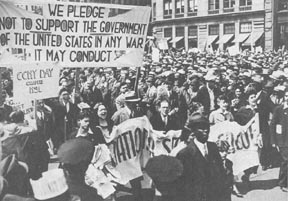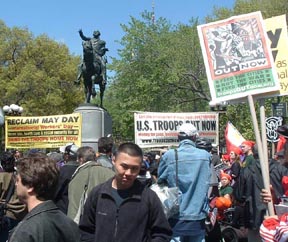
May Day Revived in New York City
And Elsewhere in the USA
May Day was born out of the fight of workers in the US for the 8-hour day. On May 1, 1886, hundreds of thousands of workers around the country downed their tools and went on strike. In the state attack that followed, police in Chicago killed six striking workers. At a mass rally protesting that repression, in Haymarket Square in that city, a provocateur threw a bomb that killed seven police officers and four workers. The police responded by arresting eight of the leaders. Four of them were hung, one committed suicide; the rest were later released after spending six years in jail.
 |
The Socialist International at that time, and later the Communist International, declared May 1st to be International Workers Day, which is celebrated all over the world. For decades, the CPUSA, when it was a revolutionary party, led tens of thousands of workers in militant May Day marches in New York City and throughout the country. However, for decades, the AFL-CIO leadership, as part of their policy of labor-management cooperation, has channeled the workers into tame Labor Day rallies and picnics, mostly to provide a platform for the Democratic Party politicians. The CP, which has meanwhile become a reformist party, has held small rallies of their followers, but without any militant class demands.
Over the last few years, there have been some attempts to revive May Day in New York City. These have been mostly by immigrant workers groups with demands centering around the super-exploitation of these workers and for amnesty for undocumented immigrants. Such a march was also held this May 1 in Bushwick, Brooklyn, by the group Make The Road By Walking against payment of below-minimum wages in the main commercial district in that neighborhood.
 |
This year, a broad attempt at reviving May Day took place. The march in New York was organized by the area branch of the Million Worker March (named for the march last October 17 which brought some 10,000 demonstrators to Washington DC) and the Troops Out Now Coalition. Some 1,000 spirited people rallied for hours in Union Square, the traditional site of May Day rallies in New York. The main demands were for jobs, a living wage, health care, housing and education, and against the war for the occupation of Iraq in the interests of the oil and other monopoly corporations.
Speakers represented militant trade union, community and anti-war leaders. They included Brenda Stokely of AFSCME DC 1707 (which includes day care and home care workers), Chris Silvera of Teamsters Local 808 (which includes workers at MetroNorth, one of the suburban rail lines), Clarence Thomas of the International Longshore and Warehouse Union on the West Coast, a representative of Casa Freehold (an immigrant workers organization in New Jersey) and Nellie Bailey of the Harlem Tenants Council. Other speakers from around the world spoke of the fights of the peoples of their home countries, from Palestine to Colombia.
The rally was followed by a short march past Beth Israel Hospital, which has been laying off workers, and by some of the local gourmet grocery stores, where workers have been trying to organize into a union. At a brief rally after the march, the police rushed in to shut of the sound system the moment the permit expired, just as Charles Jenkins of the Transport Workers Union (bus and subway workers) was speaking.
Smaller rallies were also held in other US cities, including Los Angeles, San Francisco, Chicago and Charlotte, North Carolina.
One shortcoming of the march was that, while many of the speakers represented organizations that consist overwhelmingly of workers, most of whom are Black, Latino and from other oppressed nationalities, the participants in the rally were still mainly white petty bourgeois. This reflects the fact that the left in the USA has yet to sink deep roots in the working class.
Throughout the world, millions of people have risen up, not only on May Day, in defense of their day-to-day interests and against imperialism, particularly US imperialism and its war policies. In occupied Iraq and Afghanistan, as well as in Colombia, Haiti, Philippines, Palestine and other countries, oppressed people are fighting, often arms in hand, against imperialism and their local ruling classes. In the former Soviet Union and other formerly socialist countries, working people have been fighting against the consequences of capitalist restoration – unemployment, non-payment of wages, etc. In other imperialist countries, such as France, Germany and Italy, workers have held massive demonstrations against attacks on social services, against privatization and flexibilization of labor, etc.
There are increasing attacks by the ruling class against the working and living conditions of US workers, whose sons and daughters are being sent to fight and die in the government’s "endless war" to dominate the world. In these conditions, it cannot be long until the US workers throw off the apathy and abstention from proletarian political struggle caused by decades of imperialist chauvinist propaganda and the stultifying effect of domination by the labor bureaucracy and reclaim their own history of struggle.
On to a stronger and more united May Day!
Click here to return to the U.S. Index